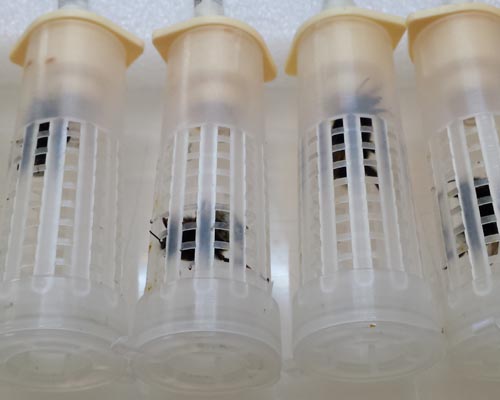OECD TG 246: Bumblebee, Acute Contact Toxicity test
Bumblebees are social insects and live in small annual-cycle colonies.
Agriculture provides habitat and forage for pollinating insects, the ecosystem service of pollination allows plants to reproduce and bumblebees are sometimes used as pollinators in greenhouses where certain crops can be grown in controlled and specific conditions. The use of plant protection product in agriculture leads to exposure of pollinators to pesticide residues, so their effects on such insects has to be assessed.
Adult worker bumblebees are exposed to different concentrations of the test substance dissolved in appropriate carrier, by direct application to the thorax (droplets) in order to evaluate the mortality and sublethal effects. Bumblebees are collected from the hives and transferred into group-housing cages. In the acclimation period (12- 24 hours) at the test conditions, bumblebees are fed with aqueous sucrose solution ad libitum and, just before the test starting, they are treated by dorsal application. Mortality and sublethal effects are assessed daily until 72 hours after the treatment. If an extention is needed, further observations are carried out at 96 hours after the beginning of the test.
TEST SYSTEM
Adult bumblebees of Bombus terrestris

STUDY DESIGN
Range finding test includes at least 3 doses of the test substance and 1 untreated control, 3 replicates for treatment and for the control with 10 bumlebees/replicate.
Limit test is carried out with 1 dose of the test substance, 1 toxic reference substance and 1 untreated control, 5 replicates for treatment and for the control with 10 bumblebees/ replicate.
Dose-response test includes at least 5 doses of the test substance, 1 toxic reference substance and 1 untreated control, 3 replicates for treatment and for the control with 10 bumblebees/replicate.
ENDPOINTS
Mortality: LD50/NOED at 24, 48 and 72 hours after treatment and behavioural abnormalities are recorded.
Study includes GLP management and reporting.
REFERENCES AND GUIDELINES
OECD Guideline fo Testing of Chemicals, No. 246 (09th Octoober 2017) – Bumblebee, Acute contact toxicity test.
Study finder
Scientific Contact
Sabrina Mantilacci
E-mail: mantilacci@biotecnologiebt.it
Phone: +39 075 895 0045 – Ext. 268
Business Contact
Katy Lazzari
E-mail: klazzari@biotecnologiebt.it
Phone: +39 075 895 0045 – Ext. 246
Need more info? Send us a message
Fill in the form with the required information (*).
Our team will be happy to provide all the necessary support with regard to your request.


 English
English Italian
Italian